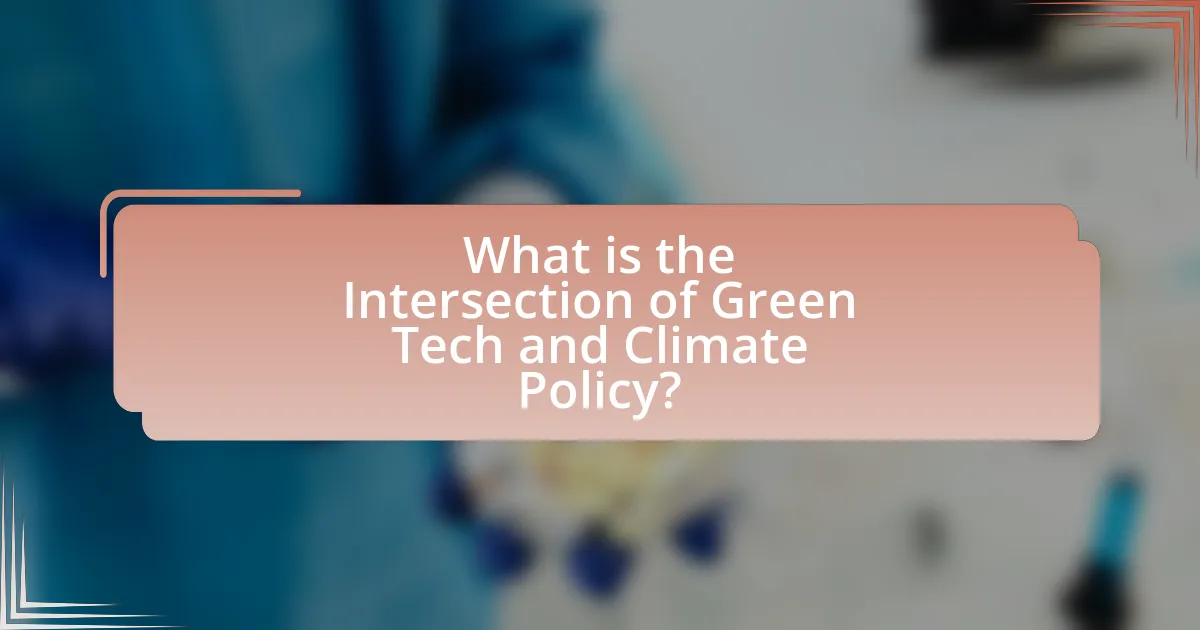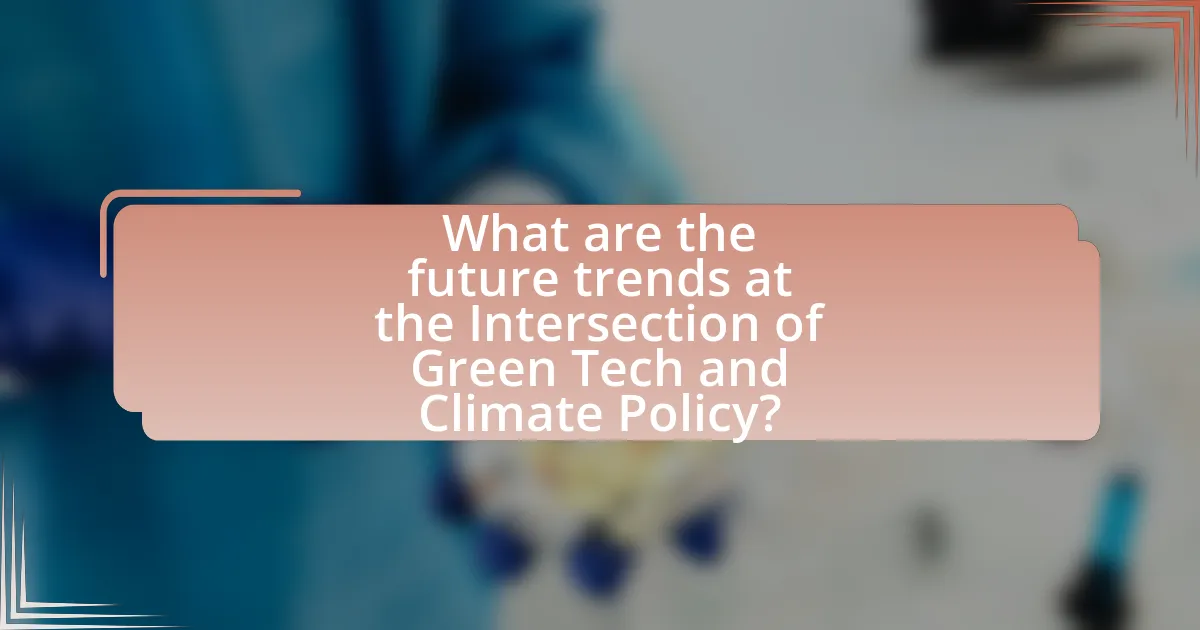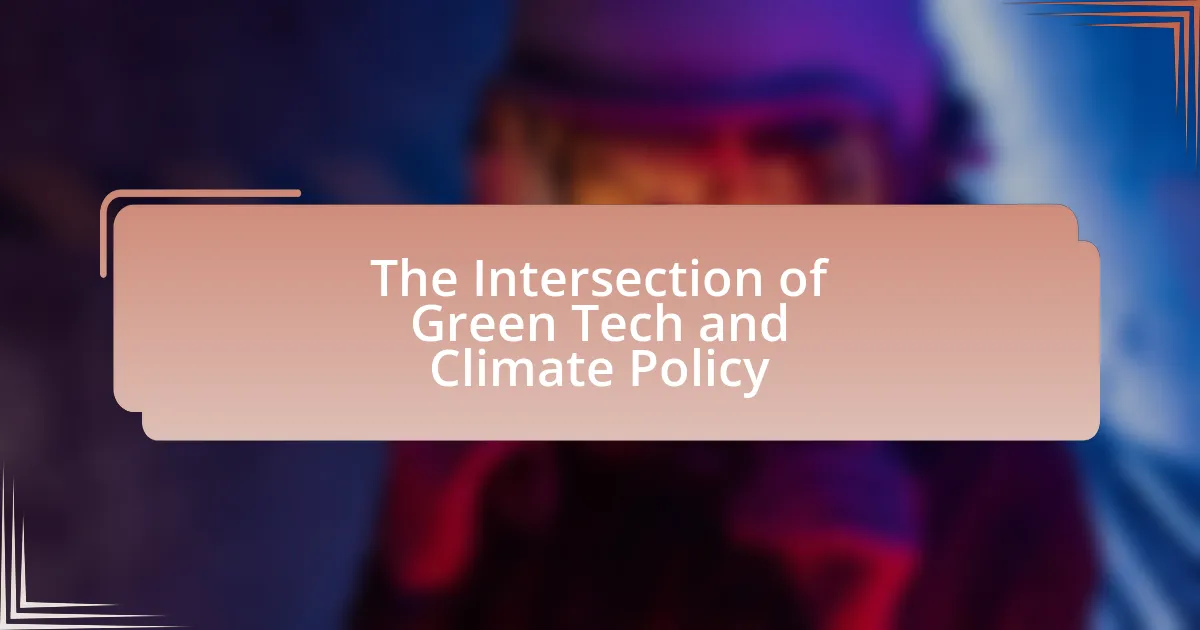The article examines the intersection of green technology and climate policy, highlighting how technological innovations aimed at environmental sustainability are integrated with governmental regulations to combat climate change. It discusses the contributions of green technologies, such as renewable energy and energy efficiency solutions, to climate policy goals, including emission reduction targets set by international agreements like the Paris Agreement. Key types of green technologies influencing climate policy are identified, along with the potential impacts on environmental sustainability and economic growth. The article also addresses challenges faced in this intersection, including regulatory hurdles and the influence of political factors, while outlining best practices for effective integration of green tech into climate policy frameworks.

What is the Intersection of Green Tech and Climate Policy?
The intersection of green tech and climate policy refers to the integration of technological innovations aimed at environmental sustainability with governmental regulations and initiatives designed to combat climate change. Green technologies, such as renewable energy sources, energy-efficient systems, and sustainable agriculture practices, are often supported and promoted through climate policies that set emissions targets, provide funding, and incentivize clean technology adoption. For example, the Paris Agreement encourages countries to invest in green technologies to meet their climate goals, demonstrating how policy frameworks can drive the development and implementation of sustainable technologies.
How do Green Technologies contribute to Climate Policy?
Green technologies contribute to climate policy by providing innovative solutions that reduce greenhouse gas emissions and promote sustainable practices. These technologies, such as renewable energy sources, energy-efficient systems, and carbon capture methods, align with climate policy goals aimed at mitigating climate change. For instance, the International Renewable Energy Agency reported that transitioning to renewable energy could reduce global CO2 emissions by up to 70% by 2050. Additionally, green technologies facilitate compliance with international agreements like the Paris Agreement, which sets targets for emission reductions. By integrating these technologies into climate policy frameworks, governments can enhance their effectiveness in achieving environmental objectives and fostering economic growth through green jobs.
What are the key types of Green Technologies influencing Climate Policy?
Key types of Green Technologies influencing Climate Policy include renewable energy technologies, energy efficiency solutions, carbon capture and storage, and sustainable transportation systems. Renewable energy technologies, such as solar and wind power, significantly reduce greenhouse gas emissions and are central to climate policy frameworks globally. Energy efficiency solutions, like smart grids and energy-efficient appliances, help decrease energy consumption and lower emissions. Carbon capture and storage technologies are crucial for mitigating emissions from fossil fuel use, capturing CO2 before it enters the atmosphere. Sustainable transportation systems, including electric vehicles and public transit innovations, aim to reduce reliance on fossil fuels and lower transportation-related emissions. These technologies collectively shape climate policies by providing viable pathways to achieve emission reduction targets and promote sustainable development.
How do these technologies align with climate goals?
These technologies align with climate goals by significantly reducing greenhouse gas emissions and promoting sustainable practices. For instance, renewable energy technologies like solar and wind power have been shown to lower carbon emissions by displacing fossil fuel use; according to the International Renewable Energy Agency, renewable energy could help reduce global CO2 emissions by up to 70% by 2050. Additionally, advancements in energy efficiency technologies contribute to lower energy consumption, further supporting climate objectives. The integration of smart grids and electric vehicles also enhances energy management and reduces reliance on carbon-intensive transportation, aligning with global climate targets set by agreements such as the Paris Accord.
Why is the Intersection of Green Tech and Climate Policy important?
The intersection of green tech and climate policy is important because it enables the implementation of sustainable technologies that directly address climate change. Green technology, such as renewable energy sources and energy-efficient systems, provides practical solutions to reduce greenhouse gas emissions, while climate policy establishes the regulatory framework and incentives necessary for these technologies to thrive. For instance, the International Renewable Energy Agency reported that renewable energy could reduce global CO2 emissions by up to 70% by 2050 if supported by effective policies. This synergy between innovation and regulation is crucial for achieving climate targets and fostering a sustainable future.
What are the potential impacts on environmental sustainability?
The potential impacts on environmental sustainability include improved resource efficiency, reduced greenhouse gas emissions, and enhanced ecosystem health. Green technologies, such as renewable energy sources and energy-efficient systems, contribute to these outcomes by minimizing reliance on fossil fuels, which are major contributors to climate change. For instance, a study by the International Renewable Energy Agency (IRENA) found that transitioning to renewable energy could reduce global CO2 emissions by up to 70% by 2050. Additionally, sustainable practices in agriculture and waste management can restore ecosystems and promote biodiversity, further supporting environmental sustainability.
How does this intersection affect economic growth?
The intersection of green technology and climate policy positively affects economic growth by fostering innovation and creating new markets. Investment in green technologies, such as renewable energy and energy efficiency, leads to job creation in sectors like manufacturing, installation, and maintenance. For instance, the International Renewable Energy Agency reported that the renewable energy sector employed over 11 million people globally in 2018, demonstrating the potential for job growth. Additionally, climate policies that incentivize sustainable practices can stimulate economic activity by encouraging businesses to adopt cleaner technologies, ultimately leading to increased productivity and competitiveness.
What challenges exist at the Intersection of Green Tech and Climate Policy?
Challenges at the intersection of green tech and climate policy include regulatory uncertainty, funding gaps, and technological integration issues. Regulatory uncertainty arises when policies do not keep pace with rapid advancements in green technologies, leading to confusion for investors and developers. Funding gaps occur as many green tech initiatives require substantial upfront investment, which can be hindered by inconsistent government support or lack of private sector interest. Additionally, technological integration issues manifest when existing infrastructure is not compatible with new green technologies, complicating their deployment. These challenges hinder the effective implementation of climate policies aimed at reducing greenhouse gas emissions and promoting sustainable practices.
What are the regulatory hurdles faced by Green Technologies?
Green technologies face several regulatory hurdles, including inconsistent policies, lengthy approval processes, and lack of standardized regulations. Inconsistent policies arise from varying state and federal regulations, which can create confusion and hinder investment. Lengthy approval processes for permits and certifications can delay project implementation, often taking years to navigate. Additionally, the absence of standardized regulations across jurisdictions complicates compliance for companies, leading to increased costs and uncertainty. These challenges can impede the growth and adoption of green technologies, ultimately affecting their contribution to climate policy goals.
How do political factors influence the effectiveness of Climate Policy?
Political factors significantly influence the effectiveness of climate policy by shaping legislative priorities, funding allocations, and public support. For instance, governments with strong political will and commitment to environmental issues tend to implement more ambitious climate policies, as seen in countries like Sweden, which has set aggressive carbon neutrality targets. Conversely, political opposition or lack of consensus can lead to weakened regulations and insufficient funding, as observed in the United States during periods of divided government, where climate initiatives faced significant hurdles. Additionally, political stability and the presence of advocacy groups can enhance policy effectiveness by fostering a conducive environment for sustainable practices and innovation in green technology.

How is Green Tech shaping Climate Policy frameworks?
Green Tech is shaping Climate Policy frameworks by providing innovative solutions that drive emissions reductions and promote sustainability. Technologies such as renewable energy systems, energy efficiency measures, and carbon capture and storage are influencing policy decisions by demonstrating viable pathways to meet climate targets. For instance, the International Renewable Energy Agency reported that renewable energy could contribute to a 70% reduction in global greenhouse gas emissions by 2050, prompting governments to integrate these technologies into their climate strategies. Additionally, the adoption of electric vehicles and smart grid technologies is reshaping transportation and energy policies, leading to more stringent emissions regulations and incentives for clean energy investments.
What role do innovations in Green Tech play in policy development?
Innovations in Green Tech significantly influence policy development by providing data-driven solutions that inform regulatory frameworks. These advancements enable policymakers to create effective environmental regulations and incentives that promote sustainable practices. For instance, the rise of renewable energy technologies has led to policies aimed at reducing carbon emissions, as seen in the implementation of the Paris Agreement, which sets targets based on technological capabilities. Furthermore, innovations such as smart grids and energy-efficient systems help policymakers assess the impact of energy consumption and develop strategies that align with climate goals. This interplay between Green Tech innovations and policy ensures that regulations are not only feasible but also effective in addressing climate change challenges.
How are policymakers integrating new technologies into existing frameworks?
Policymakers are integrating new technologies into existing frameworks by adopting regulatory measures that facilitate innovation while ensuring environmental sustainability. For instance, many governments are implementing policies that promote the use of renewable energy technologies, such as solar and wind, through incentives like tax credits and subsidies. According to a report by the International Renewable Energy Agency, countries that have adopted such measures have seen a significant increase in renewable energy capacity, with global solar power capacity growing by over 20% annually since 2010. This integration is further supported by frameworks that encourage public-private partnerships, enabling collaboration between government entities and tech companies to develop and deploy green technologies effectively.
What examples exist of successful policy adaptations due to Green Tech?
Successful policy adaptations due to Green Tech include the implementation of feed-in tariffs in Germany, which incentivized renewable energy production by guaranteeing fixed payments for solar and wind energy. This policy led to a significant increase in renewable energy capacity, with Germany generating over 40% of its electricity from renewable sources by 2020. Another example is California’s cap-and-trade program, which has successfully reduced greenhouse gas emissions by over 20% since its inception in 2013 while promoting clean technology innovation. These adaptations demonstrate how targeted policies can effectively drive the transition to sustainable energy systems.
How do international agreements influence the adoption of Green Tech?
International agreements significantly influence the adoption of Green Tech by establishing binding commitments and frameworks that encourage countries to invest in sustainable technologies. For instance, the Paris Agreement, adopted in 2015, sets targets for greenhouse gas emissions reductions, prompting nations to transition towards renewable energy sources and innovative green technologies. This commitment is supported by financial mechanisms, such as the Green Climate Fund, which provides funding for developing countries to implement Green Tech solutions. Additionally, international agreements foster collaboration and knowledge sharing among nations, facilitating the dissemination of best practices and technological advancements in the green sector.
What are the key international treaties related to Green Tech and Climate Policy?
The key international treaties related to Green Tech and Climate Policy include the Paris Agreement, the Kyoto Protocol, and the United Nations Framework Convention on Climate Change (UNFCCC). The Paris Agreement, adopted in 2015, aims to limit global warming to well below 2 degrees Celsius and encourages countries to enhance their climate actions, promoting the development and transfer of green technologies. The Kyoto Protocol, established in 1997, set binding obligations on industrialized countries to reduce greenhouse gas emissions, thereby indirectly fostering green technology advancements. The UNFCCC, created in 1992, provides a framework for international cooperation on climate change, facilitating the sharing of green technologies among nations. These treaties collectively drive global efforts toward sustainable development and climate resilience.
How do these agreements promote technological collaboration?
Agreements promote technological collaboration by establishing frameworks that facilitate joint research, development, and innovation in green technologies. These frameworks often include shared funding, resource allocation, and intellectual property arrangements that incentivize companies and governments to work together. For instance, the Paris Agreement encourages nations to collaborate on clean energy technologies, leading to initiatives like the Clean Energy Ministerial, which fosters partnerships among countries to accelerate the adoption of renewable energy solutions. Such collaborative efforts have been shown to enhance technological advancements, as evidenced by the increase in global investments in green tech, which reached $500 billion in 2020, highlighting the effectiveness of these agreements in driving innovation.

What are the future trends at the Intersection of Green Tech and Climate Policy?
Future trends at the intersection of green tech and climate policy include increased investment in renewable energy technologies, enhanced regulatory frameworks promoting sustainability, and the integration of artificial intelligence for climate modeling and resource management. Investment in renewable energy is projected to reach $2.6 trillion by 2025, driven by government incentives and private sector commitments to reduce carbon emissions. Regulatory frameworks are evolving to enforce stricter emissions targets, as seen in the European Union’s Green Deal, which aims for carbon neutrality by 2050. Additionally, the use of artificial intelligence in climate policy is gaining traction, with applications in optimizing energy consumption and predicting climate impacts, thereby facilitating more informed decision-making. These trends indicate a synergistic relationship between technological advancements and policy initiatives aimed at combating climate change.
How is public perception shaping the future of Green Tech and Climate Policy?
Public perception significantly shapes the future of Green Tech and Climate Policy by influencing political agendas and consumer behavior. As awareness of climate change increases, public demand for sustainable technologies and policies has surged, prompting governments and corporations to prioritize green initiatives. For instance, a 2021 survey by the Pew Research Center found that 70% of Americans support government action to address climate change, which has led to increased funding for renewable energy projects and stricter emissions regulations. This shift in public sentiment drives innovation in green technologies, as companies respond to consumer preferences for eco-friendly products, thereby accelerating the transition to a sustainable economy.
What role does public awareness play in policy changes?
Public awareness significantly influences policy changes by mobilizing public opinion and driving political action. When citizens are informed about environmental issues, such as climate change, they are more likely to advocate for policies that promote sustainability and green technology. For instance, the rise of public awareness campaigns around climate change has led to increased support for renewable energy policies, as evidenced by the 2019 Global Climate Strike, which saw millions participate worldwide, prompting governments to commit to more aggressive climate action. This demonstrates that heightened public awareness can lead to tangible shifts in policy frameworks, as policymakers respond to the demands of an informed electorate.
How can grassroots movements influence technological adoption?
Grassroots movements can significantly influence technological adoption by mobilizing community support and advocating for sustainable practices. These movements often raise awareness about environmental issues, leading to increased demand for green technologies. For instance, the rise of community solar projects demonstrates how grassroots initiatives can drive local investment in renewable energy, as seen in the Solarize campaigns across various U.S. cities, which resulted in a 20-50% increase in solar installations. Additionally, grassroots organizations can pressure policymakers to create favorable regulations and incentives for adopting green technologies, thereby accelerating their integration into mainstream practices.
What best practices can be adopted for effective integration of Green Tech in Climate Policy?
Effective integration of Green Tech in Climate Policy can be achieved through several best practices, including stakeholder engagement, regulatory frameworks, and financial incentives. Stakeholder engagement ensures that diverse perspectives are considered, fostering collaboration between governments, businesses, and communities, which is essential for successful policy implementation. Regulatory frameworks should be designed to support innovation and remove barriers to the adoption of Green Technologies, as evidenced by the European Union’s Green Deal, which aims to make Europe climate-neutral by 2050 through comprehensive regulations. Financial incentives, such as subsidies and tax breaks for renewable energy projects, have been shown to accelerate the deployment of Green Technologies, as seen in countries like Germany, where feed-in tariffs have significantly increased solar energy capacity. These practices collectively enhance the effectiveness of Climate Policy by promoting the adoption and integration of sustainable technologies.
How can stakeholders collaborate to enhance policy effectiveness?
Stakeholders can collaborate to enhance policy effectiveness by establishing multi-sector partnerships that leverage diverse expertise and resources. For instance, public agencies can work alongside private companies and non-profit organizations to co-create policies that address climate challenges, ensuring that regulations are informed by practical insights and technological advancements. Research shows that collaborative governance models, such as those highlighted in the 2020 report by the World Resources Institute, lead to more innovative and adaptive policy solutions, as they incorporate a wider range of perspectives and foster shared ownership of outcomes. This collaborative approach not only improves the relevance of policies but also increases stakeholder buy-in, ultimately leading to more successful implementation and sustainability of climate initiatives.
What strategies can be employed to overcome existing challenges?
To overcome existing challenges at the intersection of green tech and climate policy, stakeholders can implement collaborative partnerships among governments, businesses, and research institutions. These partnerships can facilitate knowledge sharing, resource allocation, and innovation, which are essential for developing effective green technologies. For instance, the International Energy Agency reported that collaborative efforts in renewable energy projects have led to a 30% reduction in costs over the past decade, demonstrating the effectiveness of joint initiatives. Additionally, integrating policy frameworks that incentivize sustainable practices can drive investment in green technologies, as evidenced by the European Union’s Green Deal, which aims to mobilize investments of at least €1 trillion over the next decade to support climate action.


